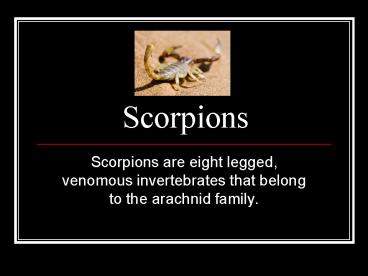Scorpions PowerPoint PPT Presentation
Title: Scorpions
1
Scorpions
- Scorpions are eight legged, venomous
invertebrates that belong to the arachnid family.
2
Adaptations
- Something an organism has to help it survive
better.
3
Three Types
Structural - How it looks. E.g. Zebras have
stripes that blend when they stand together to
confuse predators to help them survive
better. Physiological (chemical) - A chemical it
makes. E.g. A spider spins a web which catches
its prey and becomes its habitat to help it
survive better. Behavioral - Something it does. A
bear hibernates to keep warm in the winter to
help it survive better
4
Scorpions Structural Adaptations
- The pedipalps of a scorpion have tiny sensory
hairs that sense vibration in the air. The tips
of their legs contain small organs which sense
vibrations in the ground.This helps a scorpion
survive because it can tell where its prey is so
it can capture it and eat it.
5
Scorpion Structure
6
Scorpions Physiological adaptations
- The most obvious is the venom produced by its
stinger in the tail. - With this it can easily kill its food and
protect itself by stinging its prey or predator.
- The venoms are mixtures of salts, small
molecules, peptides and proteins.
7
Scorpions behavioral adaptations
- Some scorpions have been reported catching prey
at night when it is cooler. This would help the
scorpion survive because they are less prone to
dehydration when it is cooler.
PowerShow.com is a leading presentation sharing website. It has millions of presentations already uploaded and available with 1,000s more being uploaded by its users every day. Whatever your area of interest, here you’ll be able to find and view presentations you’ll love and possibly download. And, best of all, it is completely free and easy to use.
You might even have a presentation you’d like to share with others. If so, just upload it to PowerShow.com. We’ll convert it to an HTML5 slideshow that includes all the media types you’ve already added: audio, video, music, pictures, animations and transition effects. Then you can share it with your target audience as well as PowerShow.com’s millions of monthly visitors. And, again, it’s all free.
About the Developers
PowerShow.com is brought to you by CrystalGraphics, the award-winning developer and market-leading publisher of rich-media enhancement products for presentations. Our product offerings include millions of PowerPoint templates, diagrams, animated 3D characters and more.

